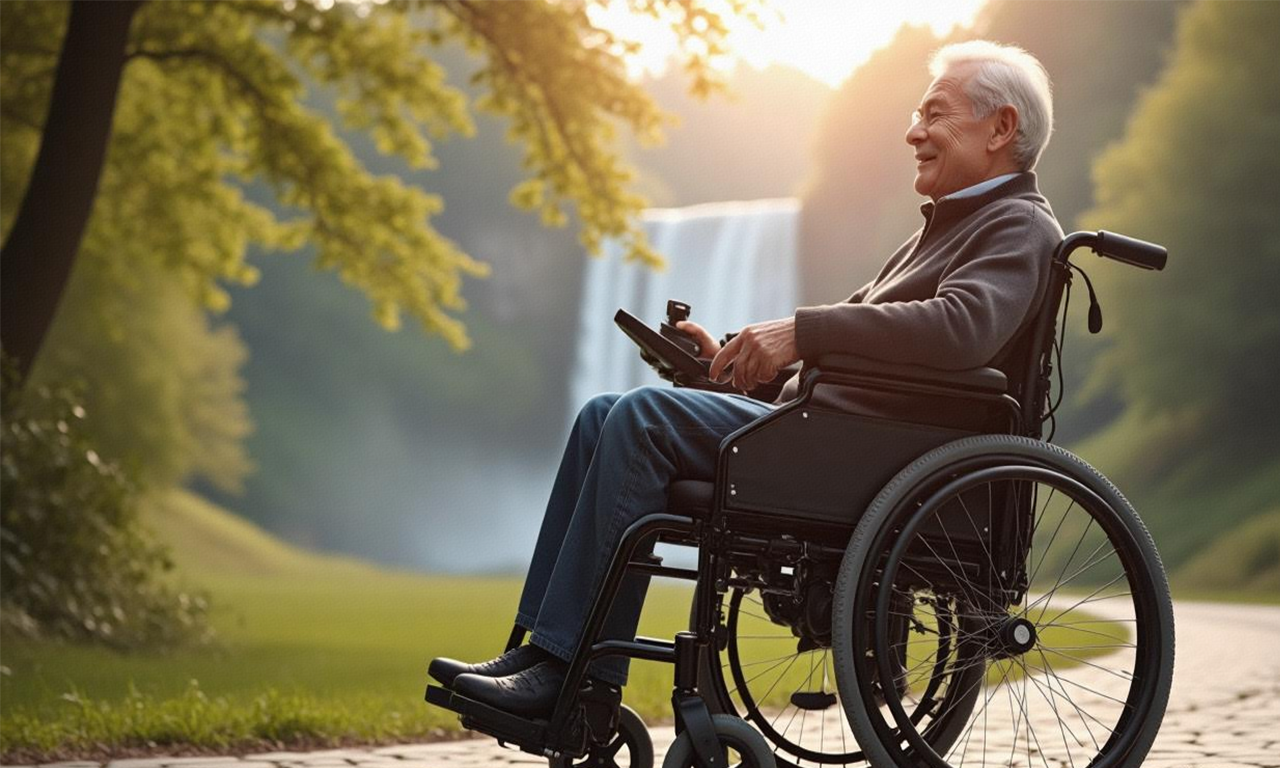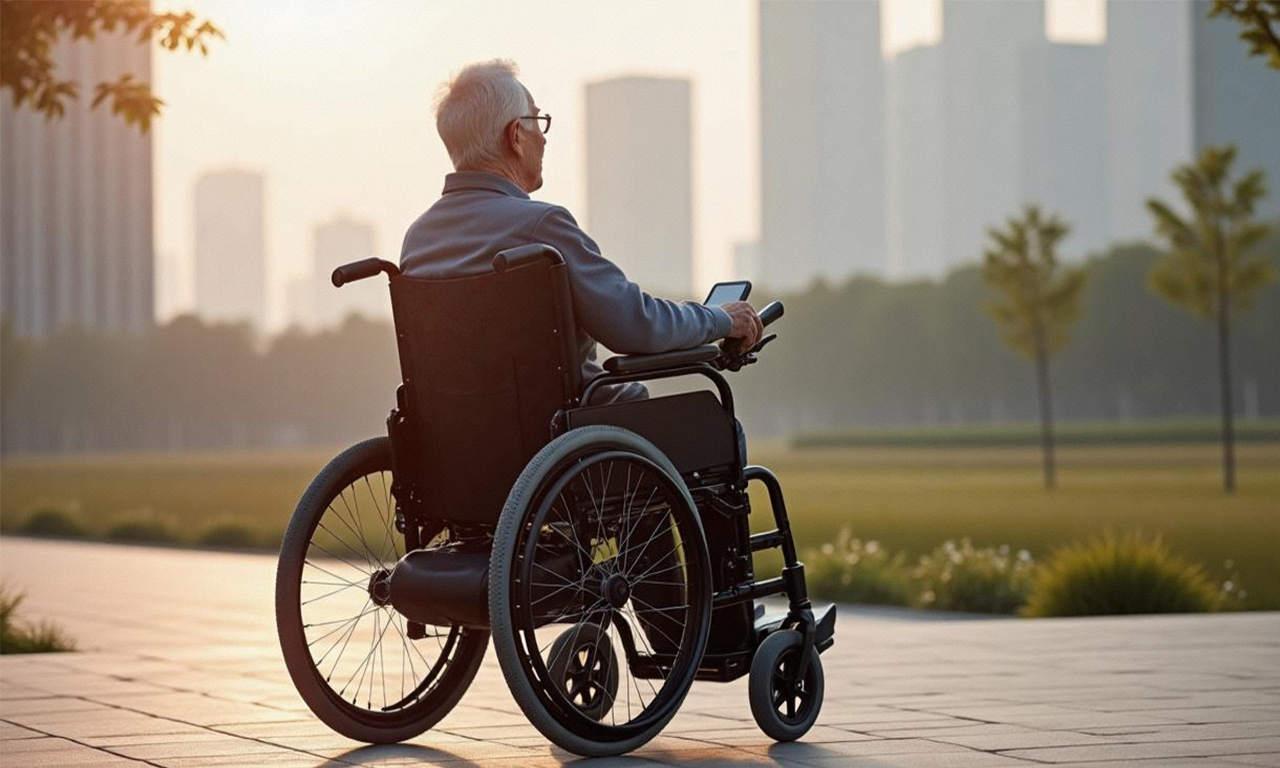For decades, the terms "electric wheelchair" and "power wheelchair" have swirled within disability communities, healthcare settings, and product marketing, often used interchangeably yet occasionally hinting at nuanced differences. This ambiguity can leave potential users, caregivers, and even professionals confused. Is there a real distinction? Does it matter when choosing a mobility solution that could profoundly impact daily freedom and quality of life?

A Journey Through Terminology: Where Did "Electric" and "Power" Originate?
Understanding the potential difference requires stepping back into the evolution of powered mobility:
- The Dawn of Battery Power (Early-Mid 20th Century): The earliest motorized wheelchairs, appearing significantly after their manual counterparts, were marvels of engineering harnessing bulky lead-acid batteries and often simplistic motors. They were almost exclusively referred to as "electric wheelchairs." This term emphasized their fundamental technological shift away from manual propulsion using electricity, clearly differentiating them from push-rim chairs. Their primary domain was often indoor or smooth, level surfaces.
-
The Rise of Robust Mobility (Late 20th Century): As technology progressed, so did user demands. Individuals desired chairs capable of venturing beyond the confines of perfectly paved indoor environments – tackling ramps, navigating varied home terrains (like carpets or thresholds), and exploring the community. This led to the development of wheelchairs with:
- More Powerful Motors: Handling inclines demanded greater torque.
- Advanced Drive Systems: Four-wheel drive, mid-wheel drive, or rear-wheel drive configurations emerged for stability and maneuverability.
- Enhanced Suspension: To improve comfort and control over bumps.
- Larger, Robust Tires/Treads: For grip on diverse surfaces, even light outdoors.
-
Heavier-Duty Frames: Built to withstand more rigorous use.
These advanced chairs were often marketed as "power wheelchairs" or sometimes "power bases." This terminology subtly suggested a higher level of capability, durability, and "power" compared to perhaps simpler, lightweight "electric" models primarily intended for basic indoor function.
Perceived Differences: A Side-by-Side Breakdown (Based on Historical/Traditional Views)
| Feature | Traditional Electric Wheelchair (Perception) | Traditional Power Wheelchair (Perception) |
|---|---|---|
| Core Purpose | Basic mobility indoors & smooth pathways | Enhanced mobility for varied terrain inclines, longer distances |
| Strength & Durability | Lighter duty construction | Heavy-duty frames, reinforced components |
| Weight Capacity | Often lower capacity (e.g., 250-300 lbs) | Higher weight capacity common (e.g., 300-500+ lbs) |
| Terrain Capability | Primarily indoor; limited outdoor (smooth) | Indoor/outdoor; handles slopes, curbs, uneven surfaces |
| Motor Power | Smaller motors (sufficient for level ground) | Larger, more powerful motors (for torque on hills) |
| Tires | Smaller, often solid; less traction | Larger tires, may be pneumatic; better grip |
| Suspension | Minimal or basic cushioning only | Advanced suspension systems for comfort/stability |
| Maneuverability | Generally good in tight indoor spaces | Can vary; some optimized for indoor, others for open outdoor |
| Portability | Sometimes designed with folding/disassembly | Rarely highly portable; often heavy & integrated |
Key Takeaway: Historically, "electric wheelchair" implied a lighter, simpler device for essential mobility on flat, smooth surfaces, while "power wheelchair" implied a more robust, capable machine built for navigating a wider range of environments and physical challenges.
The Conundrum: Blurred Lines & Modern Context
- Marketing Mix-Up: Manufacturers and retailers haven't consistently adhered to these definitions. You'll find robust, high-torque chairs marketed as "electric wheelchairs" and relatively basic folding models called "power chairs." This inconsistency sows confusion.
- Technological Convergence: Mass production advancements and component miniaturization mean high-capability features (like powerful motors, decent suspension, durable frames) are now available even on chairs prioritizing portability or cost-effectiveness.
- Consumer Expectation: Users increasingly demand "do-it-all" chairs. They want portability and the ability to handle a curb cut, navigate a bumpy sidewalk, or explore a park path. Manufacturers strive to meet this by blending features.
The Crucial Truth (2024 and Beyond): The functional difference between "electric wheelchair" and "power wheelchair" is largely semantic or historical. Focus on SPECIFICATIONS and INTENDED USE, not the label.
Why Context is King: Choosing Your Champion
Whether seeking an "electric" or "power" chair, your decision must be grounded in YOUR life:
- Primary Environment: Indoor-only? Mostly smooth pathways? Mixed surfaces? Off-road aspirations?
- Terrain Challenges: What inclines must it handle? Are curbs frequent? Nature trails?
- Portability Needs: Does it need to fit in a small car trunk? Fly frequently? Lift into a vehicle?
- User Needs: Weight capacity? Required seating dimensions? Postural support needs? Cognitive ability for controls?
- Home Access: Doorway widths? Space for maneuvering? Thresholds?
- Lifestyle: Active explorer? Commuter? Social butterfly? Focused on home independence?
Introducing the Anywell YS12-15: Where Blurred Lines Become a Strength
The Anywell YS12-15 epitomizes the evolution of modern mobility – actively dissolving the outdated boundaries between "electric" and "power" chairs. It's meticulously engineered to deliver a potent fusion of genuine power chair capability and electric wheelchair convenience/portability.
Anywell YS12-15 – Designed to Dominate Daily Life (Specs Snapshot):
- Material: Durable Carbon Steel Frame
- Dimensions (Expanded): 960 * 580 * 890mm (37.8 * 22.8 * 35.0in) – Stable base for maneuvering
- Dimensions (Folded): 720 * 360 * 700mm (28.3 * 14.2 * 27.6in) – Uniquely compact for transport/storage
- Motor Power: Robust 500W Dual Motors (2x 250W) – Torque for inclines & stability
- Max Slope: Conquers 9° inclines confidently
- Max Speed: Up to 6 km/h (3.7 mph) – Balanced for safety and progress
- Front Tires: 9.18" PU Solid Tires – Low maintenance, smooth roll
- Rear Tires: 15.7" Pneumatic Tires – Cushioning & grip for diverse surfaces
- Weight Capacity: Supports up to 100kg / 220.5lbs
- Net Weight: Just 22kg / 48.5lbs – Remarkably light for its power
- Seat Dimensions (DxWxH): 420mm x 440mm x 520mm (16.5" x 17.3" x 20.4")
- Ideal Terrain: Master of Indoor/Outdoor Hard Surfaces & Firm Grass
- Battery: Reliable 24V 12Ah Sealed Lead-Acid – Proven technology, easily replaced
Decoding the Anywell YS12-15 Advantage: Hybrid Mastery
Let's see how the YS12-15 bridges the traditional gap:
1. "Power Wheelchair" Muscle Where It Counts:
-
Dual-Motor Dominance (2x250W): This is significantly more power than found in basic "electric" scooters or chairs. It directly translates to:
- Confident Climbing: Conquering ramps (up to 9°) and driveway inclines without strain or fear of stalling is critical for real-world access.
- Effortless Acceleration: Smooth starts from stop signs or traffic lights enhance safety and user confidence.
- Reliable Performance Under Load: Maintains speed and stability even when carrying essentials or navigating thick indoor carpet, a common energy drain.
-
Proven Terrain Capability (Beyond Basic "Electric"):
- Robust Tire System: PU front tires minimize flats, while large pneumatic rear tires provide essential cushioning over cracks and bumps. This combo offers grip and comfort on pavements, asphalt, tile, low-pile carpet, and firm grass – covering typical community environments.
- 9° Climb Certification: A tangible indicator of power beyond flat indoor use.
- Durable Carbon Steel Frame: Engineered for structural integrity and daily life impacts, providing the solid "power base" feel crucial for user stability and long-term reliability. This moves well beyond lighter-duty alloys.
2. "Electric Wheelchair" Convenience & Accessibility:
-
Transformative Portability (Folding Brilliance):
- Lightweight Champion (22kg): Significantly lighter than most traditional "power wheelchairs," enabling easier lifting by an assistant.
- Ultra-Compact Fold: Shrinking to just 720mm wide and 360mm deep means fitting into most car boots/trunks (sedans, SUVs), taxis, or home storage closets effortlessly. This freedom to travel spontaneously is life-changing.
- Removable Battery: Simplifies transport weight logistics and allows charging flexibility.
- Intuitive Control & Independence: Features like the ergonomic joystick or optional attendant controls prioritize ease of use from day one. Lower cognitive load means less training time and more independent operation.
- Balanced Dimensions: Large enough for stability but compact for maneuvering through homes, offices, shops, and cafés (standard doorways ~760mm/30"). Truly designed for integrated living.
Head-to-Head: Anywell YS12-15 vs. The Competition
Let's see how YS12-15 measures up, drawing comparisons to the competitor landscape:
| Key Mobility Feature | Anywell YS12-15 | Typical Generic Foldable "Electric Wheelchair" (Competitor Weakness) | Typical Heavy "Power Wheelchair" Base (Competitor Weakness) |
|---|---|---|---|
| Folded Dimensions (WxDxH) | 720*360*700mm (28.3*14.2*27.6") | Varies, often wider/deeper | N/A - Almost never folds compactly |
| Net Weight | 22kg (48.5lbs) - Lightweight yet robust | Often similar weight range (15-25kg), BUT... | 50kg+ (110lbs+) - Heavy to lift/maneuver |
| Motor Power & Torque | 500W (2x250W) DUAL MOTORS - Strong torque | Single motor, often lower wattage (<400W total) - Weak on inclines | Typically high power (>500W) - Good torque |
| Max Climbing Angle | **9°** - Confident on ramps & moderate inclines | Often limited to 6-8° (may struggle on steeper slopes) | Typically 10°+ - Built for slopes |
| Rear Suspension (Crucial for Comfort) | Large 15.7" Pneumatic Tires - Natural shock absorption | Basic solid tires - Harsh ride on bumps & cracks | Advanced suspension common - Designed for comfort |
| Speed | Up to 6 km/h (3.7 mph) - Functional pace | Often similar max speed | May be higher (up to 8-10 km/h) - Speed priority |
| Outdoor Grip/Terrain | Pneumatic Rear + PU Front - Good hard surface grip | Primarily small solid tires - Limited to smooth surfaces | Can vary, often robust tires or treads - For varied terrain |
| Grass Capability | Stable on firm grass (e.g., park paths) | Often unstable or drains battery quickly on grass | Designed for grass/trails |
| Weight Capacity | 100kg (220.5lbs) - Ample for most users | Often limited (90-120kg) - May restrict larger users | Often high capacity (135kg+) - For diverse needs |
| Price Point (Value) | Premium Value Hybrid - Significant power without portability tax | Typically lower entry price - BUT compromises capability | Typically high price point - Investment level |
Competitor Analysis Insight: The market often forces a choice: simple portability with limited power or impressive capability with cumbersome weight/size and high cost. The Anywell YS12-15 strategically occupies the gap, offering "power chair" grade capability (dual motors, tough frame, good incline handling, pneumatic tires) WITHOUT sacrificing the essential "electric chair" portability (ultra-compact fold, manageable weight).
Pushing Boundaries: The Anywell YS12-15 Terrain Test
Forget mere specifications – let's visualize real-world dominance. The YS12-15 tackles scenarios that challenge lesser "electric" chairs while offering transport freedom impossible for bulky "power" bases:
- The Home Front: Effortless transitions across thick carpets, thresholds, and up inclined driveways (within 9°). Tight corners? Navigated with controlled precision due to its balanced dimensions.
- Concrete Jungle: Pavement cracks, uneven sidewalks, bustling curb cuts – pneumatic rear tires smooth the ride. Sudden downpours? PU front tires ensure predictable steering. A 6 km/h pace keeps pace safely.
- Community Explorer: Smooth concrete paths in local parks or the occasional firm grass verge become accessible weekend destinations. Visiting friends? That compact fold means always having it at hand.
- The Daily Commute: Need to grab a taxi quickly? Folding in seconds makes it possible. Heading to the office? Reliability indoors and outdoor adaptability ensure seamless transitions.
- Spontaneity Unleashed: Weekend trip? Throw it in the car boot. Forgot something? Attendant mode empowers help when needed without taking the wheels permanently.
Actionable Tip: When reviewing mobility devices, physically attempt maneuvers matching YOUR essential life pathways: your home doorway gradient, local slope angles, sidewalk condition quality. Does a chair visibly strain? Does handling feel shaky or sluggish? YS12-15 consistently delivers confident results where competitors falter.
Beyond the Motor: Other Critical Selection Factors
While power and portability are paramount, holistic success demands attention elsewhere:
- Seat Comfort & Fit: A perfect seat is deeply personal. Test YS12-15's dimensions carefully against yours. Does its width/depth maximize posture without pressure? Is adjustable lumbar support needed? Personalize accordingly.
- Battery Range: Consider your daily travel habits aggressively. While 12Ah offers reliable neighborhood range, adding a SECOND battery can double runtime for extended exploration. Discuss options upfront with providers.
- Control System: Joystick precision varies noticeably. Demo unit responsiveness before purchase. Those needing attendants should verify alternate controls compatibility.
- Accessibility Enhancements: Require specialized head controls? Standing function? Discuss solutions early. The YS12-15 platform can integrate specialized electronics where appropriate.
- Weight Considerations: The 22kg fold is achievable solo by many, but assess ability realistically long-term. Mechanical folding aids may become essential accessories.
YS12-15: Why Brand Integrity Matters in Mobility Tech
Choosing Anywell is choosing calculated reliability:
- Carbon Steel Durability: Beyond plastic-heavy competitors known for cracking at stress points over time. Anywell builds frameworks engineered for durability using trusted carbon steel technology.
- Proven Powertrain: Twin 250W brushless motors represent established and reliable technology backed by consistent performance metrics and longevity data.
- Responsiveness Under Pressure: A mobility device failing mid-journey creates real vulnerability. YS12-15 components pass stringent durability testing thresholds required internationally.
- Global Certification: Compliance with CE, FCC, and ROHS safety/performance benchmarks provides fundamental consumer assurance beyond anonymous brands lacking such certifications.
- Authorized Service Access: Choosing authorized distributors (like us!) ensures spare parts access, trained technician support, and honoring full warranty protections – a lifeline mainstream retail rarely matches.

Mobility Freedom: Transforming Lives Beyond Labels
Consider these journeys enabled by the YS12-15 "hybrid":
- Alex: Lives independently in a third-floor walk-up apartment (no elevator). Previously relied solely on friends for manual chair transport downstairs, severely restricting spontaneity. YS12-15's lightweight fold allows him to manage stairs independently piece-by-piece. Its power navigates city sidewalks confidently for errands or meeting friends.
- Margaret: An active grandparent enjoys visiting parks with grandchildren but found a previous "scooter" couldn't handle gentle park grass slopes or travel easily in her daughter's sedan trunk. YS12-15 conquers the grass incline comfortably and folds easily behind the spare tire.
- David: Commutes daily via paratransit to an office building. His large, traditional "power chair" required bulky vehicle space allocation and often struggled maneuvering tight office corridors efficiently. YS12-15 fits standard transport spots easily and glides effortlessly through narrow hallways and doorways without constant worry.
- Samira: Recovering from surgery limits walking endurance but not intellectual curiosity. Library visits were impossible using bulky rental chairs at home. YS12-15 fits her small car alongside groceries, empowering learning adventures once again despite temporary limitations.
- Charles & Elaine: Seasoned travelers refused cumbersome institutional chairs that couldn't adapt during RV trips nationwide. YS12-15 stows conveniently, handles rugged campsite terrain, asphalt highways safely explored via side roads, and empowers spontaneous local discovery without tour limitations.
These are just fragments of what holistic hybrid mobility enables – independence is never defined by a single word on a brochure, it’s defined by conquering YOUR daily reality seamlessly.
The Verdict: Informed Choice Is Real Power
The historical distinction between "electric wheelchair" and "power wheelchair" holds little practical weight in the evolving mobility landscape of 2024. What truly matters is matching a device's specific capabilities, durability, and ergonomics to your unique life demands and aspirations.
The Anywell YS12-15 represents a paradigm shift – a deliberate rejection of outdated compromise. It delivers tangible "power wheelchair" grade performance essential for navigating diverse terrains and tackling inclines with unwavering confidence, while simultaneously retaining the "electric wheelchair" virtues of remarkable portability, compact storage, and everyday accessibility. It’s engineered for living spontaneously without limits.
Embrace Your Journey: Discover Genuine Freedom Today
Don't let ambiguous terminology or inadequate compromises dictate your freedom. Experience the transformational difference that true hybrid design delivers:
Discover the Anywell YS12-15 – Schedule your personalized demo today!





Leave a comment
This site is protected by hCaptcha and the hCaptcha Privacy Policy and Terms of Service apply.